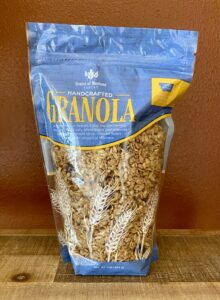Bread
Enjoy a wide variety of our breads, all made in our local bakery. Contact us for wholesale inquiries.

Enjoy a wide variety of our breads, all made in our local bakery. Contact us for wholesale inquiries.

It’s not all bread and pastries! Visit this section to learn more about what we can offer.

Satisfy your sweet (or savory) tooth with pastries, baked fresh every day. Click here to learn more about what we carry.

What’s in a Wheat Kernel?
The wheat kernel is the seed from which the wheat plant grows. Each tiny seed contains three distinct parts that are separated during the milling process to produce flour. The kernel of wheat is a “storehouse” of essential nutrients.
Endosperm
This is about 83 percent of the kernel weight. It is the source of white flour. The endosperm contains the greatest share of the protein in the whole kernel, carbohydrates, iron as well as many B-complex vitamins, such as riboflavin, niacin, and thiamine.
Bran
Bran is about 14 1/2 percent of the kernel weight. Bran is included in whole wheat flour and is also available separately. Of the nutrients in whole wheat, the bran contains a small amount of protein, larger quantities of the B-complex vitamins listed above, trace minerals, and indigestible cellulose material also called dietary flour.
Germ
Germ is 2 1/2 percent of the kernel weight. The germ is the embryo or sprouting section of the seed, usually separated because of the fat that limits the keeping quality of flour. Of the nutrients in whole wheat, the germ contains minimal quantities of protein, but a greater share of B-complex vitamins and trace minerals. Wheat germ can be purchased separately and is included in whole wheat flour.
Wheat Nutrients
Complex Carbohydrate-Wheat flour is a good source of complex carbohydrate, the most efficient source of energy available to the human body.
Fiber is the indigestible carbohydrate in food which acts like a broom to sweep our digestive tract. One slice of whole wheat bread contains 1.5 grams of dietary fiber; one slice of white bread contains 0.5 grams.
Wheat foods are moderate sources of incomplete protein. This means that while wheat and other cereal grains may contain all eight of the amino acids necessary for good health, not all eight are found at adequate levels. However, combining wheat or other cereal grains with animal proteins or legumes makes the grain protein complete. Within the cereal group, wheat contains more protein than rice or corn.
Fats account for 2 to 23 percent of wheat foods, although wheat alone contains very little fat. Most often, the fat content in wheat foods results from fat added in production, such as the oil or shortening found in many baked or fried wheat foods.
Source: smallgrains.org.
What is the difference between enriched, whole grain, and wheat bread?
Wheat bread is made from a combination of white and whole-grain flour and provides a combination of their benefits.